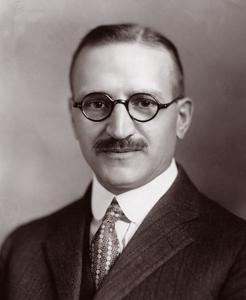
The question that I was addressing in part 1—and before that in “Whence Fact, Theory, and Path?”—concerned a familiar threefold distinction between evolution as fact, evolution as theory, and evolution as path. The question is easy enough to state: Who thought of it first? But the answer is hard to discover. In part that’s because there are so many ways of expressing the point: a writer might talk about the “path” or the “course” or the “route” of evolution on the one hand, or about the “theory” or the “causes” or the “process” of evolution on the other hand. In part that’s because so many of those ways could be used not to express the point: a writer who is discussing “the theory of evolution” isn’t necessarily restricted to discussing only the causes or the processes of evolution. So far, the earliest articulation of the distinction I’ve discussed occurs in Principles of Animal Biology (1920), by A. Franklin Shull (above), which might have influenced Winterton Curtis’s use of it in his testimony for the Scopes trial in 1925.
But wait a minute! Didn’t Darwin himself enunciate the distinction? T. Ryan Gregory, himself the author of a modern statement of it—“Evolution as Fact, Theory, and Path” (PDF) which appeared in Evolution: Education and Outreach in 2008—suggested in a comment on “Whence Fact, Theory, and Path” that he did, citing two passages from Darwin. In the clearer of the two, from The Descent of Man (1871), Darwin wrote, “I had two distinct objects in view, firstly, to shew that species had not been separately created, and secondly, that natural selection had been the chief agent of change.” But although Darwin is here distinguishing between fact and theory/cause, he is not mentioning path/course, and Gregory acknowledged that “Darwin didn’t have much to say about this in the Origin.” Perhaps it’s understandable that Darwin was focused on the theory. As Michael Ruse noted in Darwin and Design (2004), “Without causes, he was no more than one among many evolutionists. With causes, he might become the Newton of biology.”
Even if Darwin didn’t enunciate the threefold distinction, it seems unlikely that there are any statements of it before 1859: although there were people thinking about evolution as fact, evolution as theory, and evolution as path before Darwin, it was his work that sparked scientific interest in these topics. So I spent a bit of time looking for statements of the distinction between 1859 and 1920. The earliest I presently have in hand is from 1907. In “The Geographic Distribution of Closely Related Species,” published in The American Naturalist, Robert Greenleaf Leavitt (1865–1942) clearly enunciated the distinction: “I do not agree with D. H. Scott, that the determination of the actual course of descent is the ultimate, or chief, object of the scientific systematist. The fact of evolution being admitted, and the course of evolution having been ascertained, there still remains the question, ‘By what methods have new forms emerged from old ones?’—a subject not less interesting or important than the others, from any point of view.”
Leavitt was referring to a 1907 article by the botanist Dukinfield Henry Scott (1854–1934) in Progressus Rei Botanicae (which I was astonished to find on-line). In it, there’s no sustained argument for the thesis that Leavitt disagrees with: Scott begins with the assertion, “Since the publication of the ‘[On the] Origin of Species’ and the consequent general acceptance of the doctrine of evolution, the determination of the course of descent has become the ultimate object of the scientific systematist,” but quickly turns to his main purpose, providing a state-of-the-art review of paleobotany. Interestingly, Scott may have heeded Leavitt’s criticism. For not long after, in a piece published in a volume to celebrate the centenary of Darwin’s birth, Darwin and Modern Science (1909), he writes, “We may consider the fossil record of plants in its bearing: I. on the truth of the doctrine of Evolution; II. on Phylogeny, or the course of Evolution; III. on the theory of Natural Selection,” and organizes his remarks accordingly.
Perhaps there are earlier statements of the threefold distinction to be found. I suspect, though, that Shull’s Principles of Animal Biology is the earliest source to be influential. In his biography for Shull in the Complete Dictionary of Scientific Biography (2008), Garland Allen writes, “Although a researcher of considerable merit, Shull is perhaps best remembered in American biology for his teaching and writing,” adding that his textbooks “introduced countless students to modern, experimental biology and to rigorous concepts in general biology.” He is credited with pioneering the “principles” approach to biology, organizing his courses and his textbooks around general themes rather than—as was common—along a march through phylogeny. There were six editions of Principles of Animal Biology, the latest in 1946. Even if Leavitt is granted the priority for drawing the threefold distinction, it is hard to believe that a single paper in a journal would have had the same influence as a textbook studied by generations of undergraduate students.

